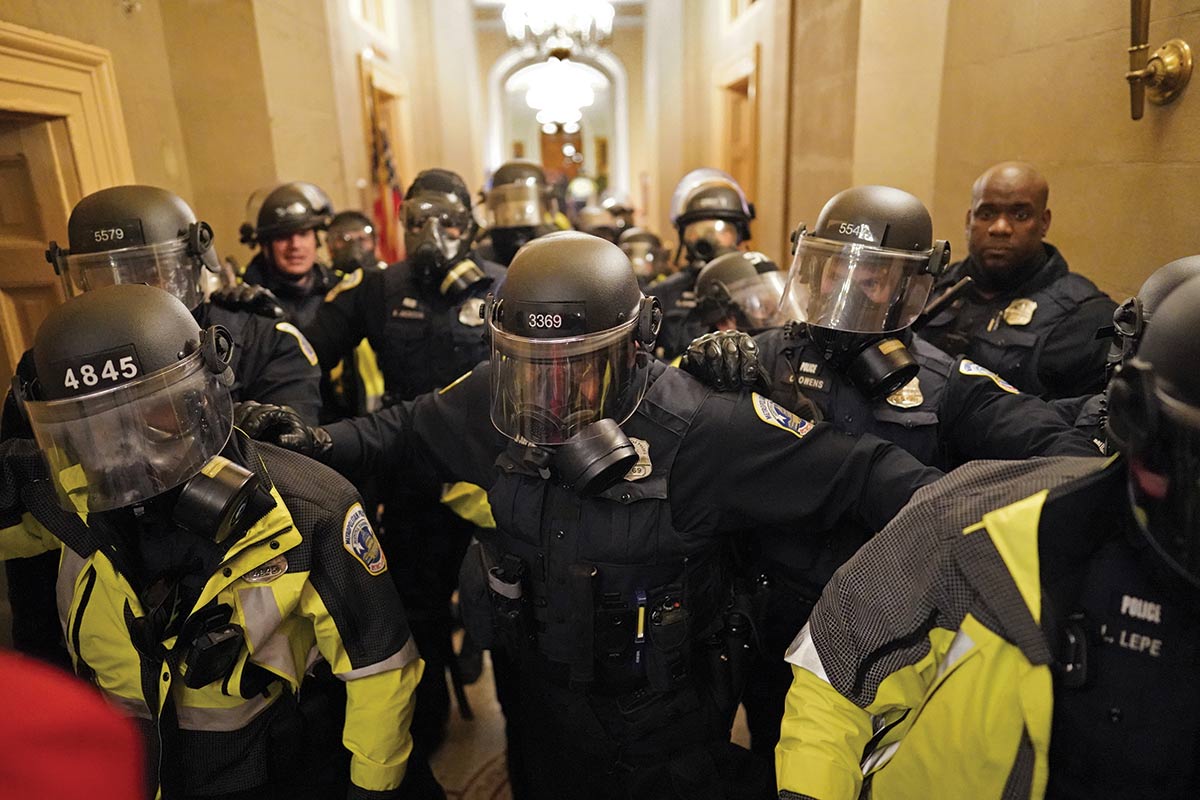Simulating the Aftermath of a Contested Election
Using role-play, a politics class studied how protest movements might react today to a Jan. 6 situation.

Photo Credit: Kent Nishimura / Los Angeles Times via Getty Images
By David Levin
In America’s polarized political environment, the relationship between law enforcement and protesters has become increasingly important to understand, says Daniel Kryder, the Luis Stulberg Chair in Law and Politics.
Though most demonstrations play out peacefully and safely, a few end in tragic violence. In some of these cases, police instigate the violence. In others, like the Jan. 6, 2021, riot at the U.S. Capitol building, law enforcement itself is targeted.
Social scientists want to know how and why clashes like these occur. So, for a class called Police and Social Movements, Kryder and teaching assistants Anja Parish, GSAS PhD’24, and Jamie Morgan, Heller PhD’23, developed a massive role-playing simulation that let students experience how police and political groups might react to a hypothetical contested election. (The simulation framework was published in March 2023 in the journal PS: Political Science and Politics.)
“Most political science literature on American politics concerns the regular operation of our formal constitutional system — elections, the presidency, the Congress, the courts,” Kryder says. “But a lot of political action occurs outside these realms. We thought creating a scenario like Jan. 6 would really help students understand how social movements and authorities shape politics, and how individuals within these organizations reason, decide, and act.”
To begin the scenario, Kryder and his teaching assistants assigned students to right-leaning groups (the Proud Boys, QAnon, and others), left-leaning groups (Black Lives Matter and Antifa), or law enforcement (the Capitol Police, the FBI, and so on).
Students had to know their group inside and out — its strengths and weaknesses, modes of communication, guiding philosophy, and overall goals — and then use these attributes to write a detailed weekly “move,” laying out the group’s plans for the next seven days. Parish, Morgan, and Kryder summarized these moves in a “presidential brief” that updated the simulation, which students used to decide what their group would do next.
“The MAGA group might say, ‘Our immediate goal is starting an outcry that questions the legitimacy of the election. We’re going to spread misinformation on social media; we’re going to file frivolous lawsuits,’” Parish explains. “Some of the groups got really granular and wrote specific tweets or public messages they’d spread. The QAnon group even made cryptic posts for Reddit.”
As the simulation progressed, Parish, Morgan, and Kryder positioned all the groups on the ground in Washington D.C., and let their students role-play out the actions of each group as they simultaneously converged on the Capitol. Before long, the scenario spiraled into something eerily familiar — a wave of right-wing protesters attempting to storm the building.
Yet the aftermath was notably different from what actually happened on Jan. 6. “Toward the end of the simulation, the right-wing groups not only got into the Capitol, they holed themselves up in there,” says Parish. “They barricaded the building so no one could enter or leave, and then sat there.”
Meanwhile, the police response remained tepid at best, Morgan says, since students playing law enforcement roles were reluctant to arrest or use force on their classmates, even symbolically.
“We didn’t count on that at the start,” she says. “Students are very aware of historical trends of police overreacting, so we had to push them a bit. Is this how your group would react in the real world? Do you really think the D.C. police would not arrest people in the Capitol?”
Despite the inevitable moments of awkwardness or discomfort, the simulation received glowing feedback from most of the class, and students seemed to walk away with a deep understanding of how polarized groups can clash.
Parish, Morgan, and Kryder would like to repeat the role-playing scenario. They also encourage other educators to adapt its framework for their own classroom.
“Every one of our students said this was something that made abstract theoretical concepts feel real, instead of just going to a lecture and hearing about them,” says Parish.
“If you have a semester, or even a month or two, this could be a really useful tool in all kinds of educational settings, not just courses about social movements.”